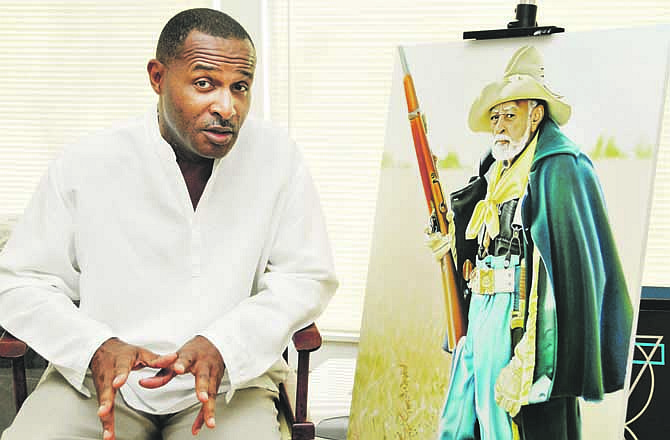JEFFERSON CITY, Mo. -- No records were kept of the 1st Kansas Colored Volunteer Infantry, so local artist Essex Garner was told. But he has thousands of photos from those soldiers' descendants to prove otherwise.
And now Garner is crafting those images and the ancestral stories into "Art: Portraits of America, The Buffalo Soldier."
A few of the portraits are on display through Feb. 28 at the Missouri Army National Guard Headquarters in Jefferson City. And Garner will discuss this series and previous work from 9-11:30 a.m. Wednesday at the Ike Skelton Training Center.
The 1st Kansas were the first black unit in the Civil War to engage in combat. The recently established Battle of Island Mound State Historic Site marks the 1862 skirmish with pro-Confederates near Fort Africa, where the 1st Kansas was camped near what is Butler today.
With pride, several descendants of those soldiers attended the state park dedication in October.
Garner met Cathy Williams, a descendant of the woman by the same name who hid her gender to fight in the Civil War. Another 1st Kansas descendant attended in his father's 1st Sergeant uniform with accompanying weapons.
"There would have been no Buffalo Soldiers, if we didn't have Island Mound," Garner summed.
A retired U.S. Army draftsman and officer, Garner identified with overcoming adversity, which these soldiers and their families faced, he said.
"Their wives and daughters were raped, and they were sold as property," Garner said. "They were never to be educated, and they were whipped like cows."
Just prior to the September 1862 battle, President Abraham Lincoln, who was not a believer in black regiments, had offered a 40-year extension of slavery to southern states, Garner noted.
But after the free blacks and former slaves soundly defeated the Confederate soldiers at Island Mound, Garner believes that swayed the president to move forward with the Emancipation Proclamation instead.
"They were not an authorized regiment; they were not paid and they had no orders," Garner said. "At Cog Hill, they were disorganized but beat back the Red Legs."
Garner's previous portrait series "Learning to Read, A Soldier's Story" illustrated the plight of black Civil War soldiers and celebrated the 62nd and 65th Colored Infantries, which founded Lincoln University.
Among all black soldiers, reading became a priority because they needed to read general orders and could not promote without the aptitude, he said.
Mostly, the black units were used for manual labor, though.
"Lincoln didn't free the slaves; the slaves freed themselves," Garner said.
Several organizations already want to show Garner's Buffalo Soldiers series, even though he's several months away from completion.
Fort Leavenworth, where the 1st Kansas was based, will include the series as part of its unveiling of Colin Powell's bust, probably later this year.
Perhaps Garner's next portrait series will remember the "Red Tails," since a couple of the Tuskegee Airmen were from Lincoln University, he said.
At age 11, Garner's art teacher helped secure for him an apprenticeship with Hallmark Cards.
At age 14, he ran away from home in Kansas City for a summer, finding support at the art research center. Later, those connections would lead to his wall graphics across the city.
At age 17, Garner chose the military over a scholarship to the Kansas City Art Institute. But his talent was obvious, so his superiors soon put him to work as a draftsman.
Without a high school diploma or college degree, it was his raw talent repeatedly that carried him through several jobs without ever filling out an application.
But his grandmother made only one request, that he would continue his education.
So he earned his GED and then continued to take college classes, until retirement in 2003.
Then, he pursued his bachelor's degrees at Lincoln University in art education and fine arts, and a master's of art education from the University of Missouri.
Now, he teaches art at Lincoln, cares for his family - wife Larna and daughters Princess and Grace - and he paints.
Because his work for the military and other public projects left him with little in his personal portfolio from a 20-plus year career, Garner now publishes and promotes for himself.
He now has nearly 70 images copyrighted on his own. He hasn't done gallery showings in years.
He enjoys the education component, which first was sparked by his wife, who has taught at East Elementary School for about 20 years.
Together, they created the first children's book about President Barack Obama, he said.
"I take lessons in education and stick them in my art," Garner said. "I want everything historically accurate, down to the last shoestring - not idealized, but exactly what it would have been like."
Battle was historic first
Information gathered from the Associated Press and the Missouri State Parks.
The Battle of Island Mound near modern-day Butler marked the first time black troops were engaged in Civil War combat, nearly a year before the battle depicted in the film "Glory."
The Battle of Island Mound State Historic site encompasses Fort Africa, where the 1st Kansas Colored Volunteer Infantry were camped in 1862, before a pitched battle with pro-Confederate forces near a low hill named Island Mound.
Courage Trail offers an interpretive loop visitors may walk and learn about the history that unfolded as a result of that skirmish.
Once war was declared, the number of black refugees increased in Kansas. By the summer of 1862, former slaves were recruited into what would become the 1st Kansas Colored Volunteer Infantry. Union military officials in Kansas recruited them months before the federal government officially would allow blacks into military service.
By August 1862, the 1st Kansas Colored Volunteer Infantry had grown to about 500 soldiers - enrolled, uniformed, armed and trained into a disciplined unit and ready for action. Orders came in October 1862 and a detachment of more than 225 infantrymen and a company of cavalry scouts left their base in Kansas for Bates County, where they were "to proceed to a point on the Osage, Bates County, Missouri, and there break up a gang of bushwhackers."
What would follow was the first instance of black troops being directed to oppose forces aligned with the Confederacy the American Civil War.
The battle, or skirmish, was not large; seven Kansas enlisted men and one officer were killed and guerilla losses are unknown but may have been more than 30.
What was particularly significant was the attention that this action received in the national media and the effect it had upon military and political skeptics of arming former slaves. Reports of the success of the First Kansas Colored Volunteer Infantry against a larger opponent and of the ferocity that they showed that day encouraged other federal black units forming elsewhere.
Almost 200,000 black soldiers would become engaged during the Civil War.


